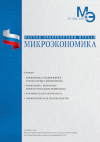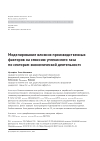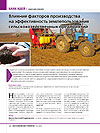Modeling the impact of production factors on carbon dioxide emissions by sectors of economic activity
DOI: 10.33917/mic-4.111.2023.29-41
The solution of climate problems, accompanied by the development and implementation of carbon regulation mechanisms in international markets, determines the need to reduce the carbon intensity of the Russian economy in order to maintain its competitiveness. The article analyzes the influence of production factors on total CO2 emissions in Russia on the basis of official statistics. During the study, it was hypothesized that the improvement of production factors will contribute to the reduction of CO2 emissions. To test it, a simulation based on panel data was carried out. Special attention was paid to the problem of CO2 emissions by sectors of economic activity.
References:
1. Head of the Ministry of Economic Development Reshetnikov: Russia will continue its course towards decarbonization. Russian newspaper. URL: https://rg.ru/2023/01/25/reshetnikov-rossiia-prodolzhit-kurs-na-dekarbonizaciiu.html
2. Why there is no more hope for oil and gas and what should Russia do. – interview with I. Bashmakov. URL: https://plus-one.ru/economy/2023/02/22/pochemu-nadezhdy-na-neft-i-gaz-bolshe-net-i-chto-delat-rossii
3. Experts assessed Russia’s spending on combating carbon emissions under sanctions. URL: https://www.rbc.ru/economics/07/02/2023/63e0facd9a79474b9ad80886
4. The head of the Russian Union of Industrialists and Entrepreneurs called for a reconsideration of the «Western» approach to climate problems. URL: https://www.rbc.ru/economics/17/02/2023/63ef549b9a794761544d52f
5. Bai J., Jakeman A. J., McAleer M. Estimation and discrimination of alternative air pollution models. Ecological Modeling. 1992;64:89–124.
6. Grossman G., Krueger A. Economic growth and the environment. The Quarterly Journal of Economics. 1995;110:353–377.
7. Selden T. M., Song D. Environmental quality and development: is there a Kuznets curve for air pollution emissions? Journal of Environmental Economics and management. 1994;27(2):147–162.
8. Lean H. H., Smyth R. Multivariate Granger causality between electricity generation, exports, prices and GDP in Malaysia. Energy. 2010;35(9):3640–3648.
9. Saboori B., Sulaiman J., Mohd S. Economic growth and CO2 emissions in Malaysia: a cointegration analysis of the environmental Kuznets curve. Energy policy. 2012;51:184–191.
10. Bimonte S., Stabile A. Land consumption and income in Italy: a case of inverted EKC. Ecol Econ. 2007;131:36–43.
11. Ulucak R., Bilgili F. A reinvestigation of EKC model by ecological footprint measurement for high, middle- and low-income countries. Journal of Cleaner Production. 2018;188:144-157.
12. Shafik N. Economic development and environmental quality: an econometric analysis. Ox- ford economic papers. 1994;46(4):757–774.
13. Azomahou Theophile, Laisney Francois, Nguyen Van Phu. Economic development and CO2 emissions: A nonparametric panel approach. Journal of Public Economics. 2006;90 (6-7):1347-1363.
14. Golley J., Meng, X. Income inequality and carbon dioxide emissions: the case of Chinese urban households. Energy Economics. 2012;34 (6):1864-1872.





